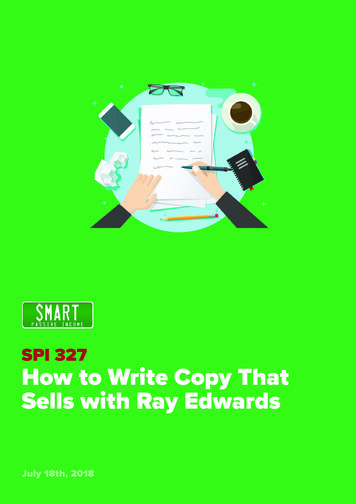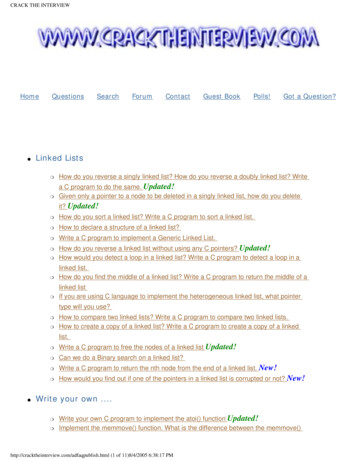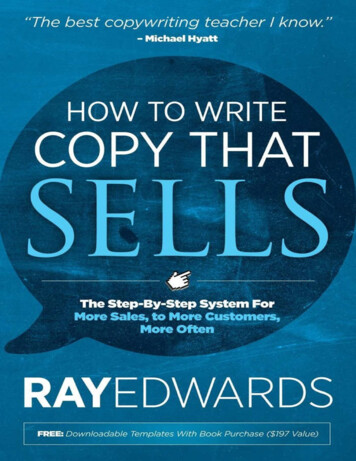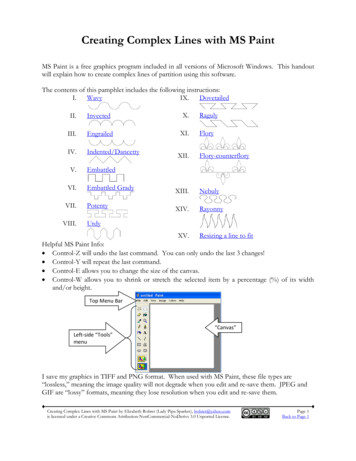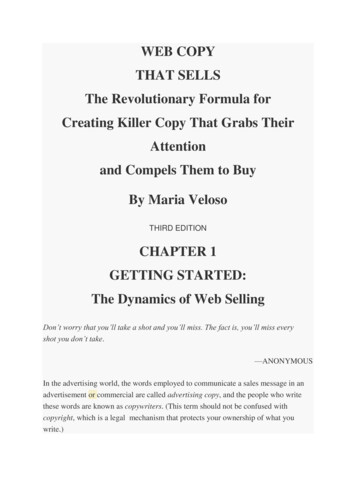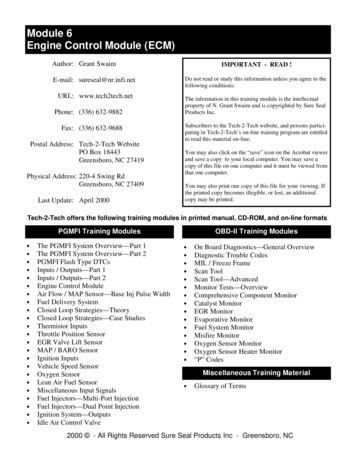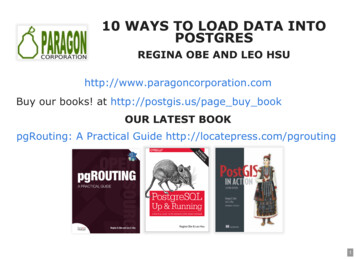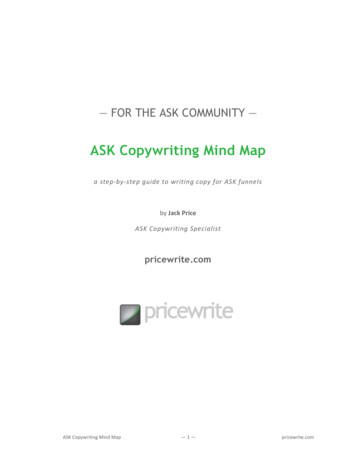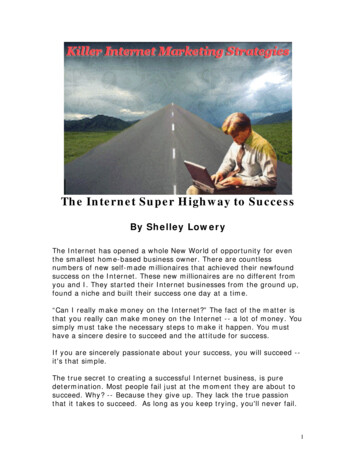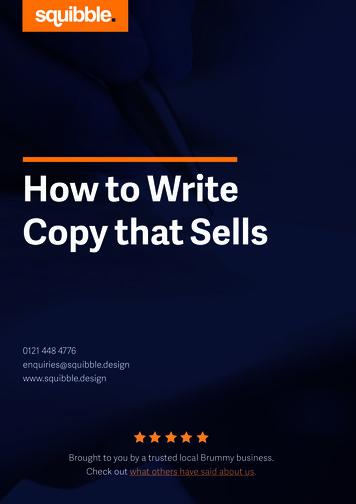
Transcription
How to Write Copy that SellsHow to WriteCopy that Sells0121 448 ought to you by a trusted local Brummy business.Check out what others have said about us.www.squibble.design
“Here’s the only thing you’re selling, nomatter what business you’re in and whatyou ship: you’re selling your prospects abetter version of themselves”.– Joanna WiebeMarketers, business owners, brand managers - there’s one situation thatevery last one of these people have been in.Sat in front of their stone-cold computer keyboard, with the cursorblinking at them - intimidating them, while their mind is as blank as thepixel-based piece of paper before them.Struggling to find the right words is perhaps the number one gripe wehear from our clients when it comes to their marketing efforts. So let’saddress it. Here’s how to move from writer’s block to compelling copythat gets calls or clicks.enquiries@squibble.design 44(0)121 448 4776
How to Write Copy that SellsKey Question - Should You Use a Content Template?We’ve created a content template doc for you to download. ButWHY we hear you ask.Well, they deliver 2 helpful advantages to the stuck-for-wordswriter 1. They help you keep focus on a content-first approach foryour website, rather than having to find the words to fit intoa design2. Your template will give clarity to your designers anddevelopers (plus, they won’t need to keep hassling you foryour content!)Now let’s move onto how you’ll find the words to put theseassets to good use.www.squibble.design
Understand the Difference BetweenBenefits and Features“The vast majority of products are sold because of the need for love,the fear of shame, the pride of achievement, the drive for recognition,the yearning to feel important, the urge to look attractive, the lust forpower, the longing for romance, the need to feel secure, the terror offacing the unknown, the lifelong hunger for self-esteem and so on”.– Gary BencivengaDon’t focus on the specs first - the smallest details, the materials,components, technology. Paint the picture of how your audience’s life willbe improved merely by owning your product or using your service.If you’re selling a home alarm system, don’t talk about how many decibelsit rings out, or how the remote app has 15 settings.Talk instead about how those who buy the alarm will be safer - how they’llhave the ability to know that their home is secure even when at work.“Your job is not to write copy. Your job is to know your visitors, customers and prospects so well, you understand the situation they’re in rightnow, where they’d like to be, and exactly how your solution can and willget them to their ideal self”.– Joanna Wiebeenquiries@squibble.design 44(0)121 448 4776
How to Write Copy that SellsRing combines a rundown of product features with the powerful messageof “home security like never before - for security beyond the home”. Thisis an excellent example of selling the life that consumers could have - onethat is safer and more secure. And don’t we ALL want that?Now let’s look to a service-based example. MailChimp doesn’t talk aboutthe details of their CRM (the dashboard, the segmentation tool, themessage automation). They keep it simple and finely focused on thebenefits.www.squibble.design
Writing for the WebAs we’ve briefly touched on, words should always come before webdesign. Why? For three very good reasons You must know the EXACT purpose of a page before designing it should it educate your audience, build trust, or perhaps it shouldmake the final pitch to push for conversion. Your devs and designers are far better served having the finalisedcontent to create around, rather than reverse engineering. Content will always need a final review before the green light is givento publish - if the content is on a live web page you’ll need to messaround with firing off emails to your devs to make tweak after tweakafter tweak.enquiries@squibble.design 44(0)121 448 4776
How to Write Copy that SellsPut Together a PlanHere are six questions to answer before putting pen to paper or fingersto keyboard. What are you writing? A product page, a landing page, softwaredocumentation etc. Where will it be published? Your website, a brochure, a social mediaprofile etc. When will it be published? And when will you need to start writing inorder to meet your deadline? Who is the target audience? Do you have buyer personas to workfrom? What message do you need to communicate? What is the ultimate purpose/goal of the page? How does thepurpose of this page fit in with the overall experience of the website? What questions should your content answer? Why is your audiencesearching out this information?www.squibble.design
Develop That Plan into An OutlineFrom this six-answer plan you should create an outline of your content(even if this just means jotting a few things down on some post-it-notes).A.I.D.A is a solid tool for developing an outline. A.I.D.A stands for Attention - What’s the benefit/promise your product or service has?Keep it quick and easy - simple and straightforward. Interest - Make sure you quickly deliver on the promise of the firststep, otherwise your reader might leave. Desire - Time to tell a story that causes something to click in thereader - something that makes them want to take Action - Finish by telling your reader what they should do next. Makesure the call to action is clear and compelling.Your outline should help you keep on topic.enquiries@squibble.design 44(0)121 448 4776
How to Write Copy that SellsNow Let’s Get to Some Specifics: Headings,Sub-Headings, BodyThe Anatomy of the Perfect HeadlineYour page headline should be: A reasonable size and always positioned at the top of the page Short, snappy and direct - between six and seven words Descriptive of what the reader can expect and how they’ll benefitTurning to a well-worn copywriter’s concept, keep to the four U’s ofheadlines Useful Urgent Unique Ultra-SpecificTake your heading for a test with the CoSchedule’s Headline Analyzer.www.squibble.design
Sub-Headings Avoid going too crazy on the creativity Keep your headings reasonably short (between six and nine words) Try to focus on the most important part of the paragraph Avoid puns, cliches and cryptic wordsConsider Keeping Your Headings to a Parallel Structure and LengthThe following are all similar because of their ‘ing’ - the instructions linkup and the process is clear (treating every sub-heading as a step forwardshould apply to ALL copy, whether the content is a step-by-step processor not). Also notice how the sub-headings are similar in length.Heading of article:Tips for Installing Solar Panels at HomeSubheading 1:Getting Your Home ReadySubheading 4:Placing and Securing MountsSubheading 2:Choosing the Right SpotSubheading 5:Fastening Mounts to Solar PanelsSubheading 3:Figuring Out Your Lateral TiltSubheading 6:Connecting Solar Panels toenquiries@squibble.design 44(0)121 448 4776
How to Write Copy that SellsReady for your FREE brand consultation?30 minutes. 1 Expert. Absolutely, totally FREE (no catch).During these 30 minutes you’ll receive the following (for FREE). Get honest advice on where to start or what to do next; An opportunity to brainstorm ideas and share your thoughts; Recieve marketing ideas to generate sales.And this is Kim (who your call will be with).Kim started Squibble in 2010 and has since grown the business toinclude past clients like McDonalds, Auto Trader and Marks & Spencers.Kim has led many top level campaigns for leading brands in the UK andbecause of this holds a strong position within the industry.Kim is multi-award winning, having scooped ‘Young Entrepreneur of theyear 2016’, made finalist for ‘Birmingham Business Woman of the Year2018’ and picked up ‘Digital & Creative Business of the Year 2017’ for heragency.www.squibble.design
0121 448 ought to you by a trusted local Brummy business.Check out what others have said about us.
How to Write Copy that Sells www.squibble.design Ring combines a rundown of product features with the powerful message of "home security like never before - for security beyond the home". This is an excellent example of selling the life that consumers could have - one

